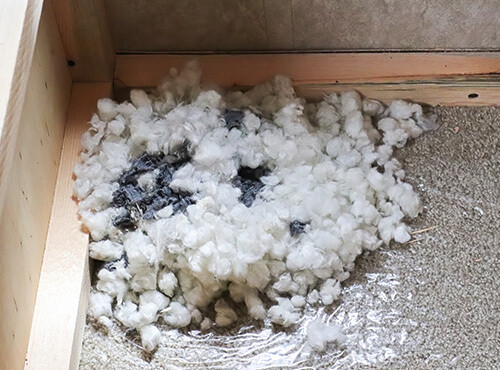Rats, particularly Norway rats (brown rats) and roof rats (black rats), are common pests that can quickly become unwelcome houseguests. Understanding where rats live is crucial for effective pest control and prevention. These nocturnal creatures thrive in urban and suburban environments, seeking access to food, water, and shelter, often leading them into our homes and yards.
Where Do Rats Live Inside Your House?
Rats are opportunistic nesters, choosing locations that offer warmth, security, and easy access to resources. If rats are in your house, they will prioritize areas that are secluded and undisturbed. Common indoor rat nesting sites include:
- Attics: Attics provide ample nesting material like insulation and stored items. Rats may build nests within the insulation itself or utilize ductwork, creating a hazard for heating and air conditioning systems.
- Walls and Ceilings: The spaces within walls and ceilings offer protection and darkness, making them ideal for rat nests.
- Under Appliances: Areas behind refrigerators, ovens, and dishwashers are often warm, secluded, and close to potential food sources in the kitchen.
- Cabinets: Kitchen and bathroom cabinets, especially those less frequently accessed, can become nesting sites.
- Eaves: The overhanging edges of roofs provide sheltered spots for rats to nest.
- Crawlspaces: These low, dark spaces under houses are favored, particularly by Norway rats who prefer ground-level nesting.
- Basements: Basements, often damp and less frequented, offer shelter and potential access to plumbing and other entry points.
Norway rats are more likely to nest in basements and crawlspaces, while roof rats, adept climbers, often choose attics and upper levels of homes.
Where Do Rats Live In Your Yard?
Rats also establish habitats outdoors, often near human dwellings where food and shelter are readily available. Outdoor rat locations vary depending on the species:
- Norway Rats: These rats are burrowers, creating extensive tunnel systems for shelter and protection. Rat burrows are typically found:
- Under vegetation and dense ground cover
- Beneath rocks, logs, and debris piles
- Near building foundations, porches, and patios
- Under sheds and other outbuildings
- If they access attics, they may even create burrows within insulation.
- Roof Rats: As their name suggests, roof rats prefer elevated locations. In yards, they commonly nest:
- In trees, especially dense canopies
- Within firewood piles
- In shrubs and overgrown vines
Rats are also known to nest under car hoods, seeking warmth and shelter, highlighting their opportunistic nature.
What Does a Rat’s Nest Look Like?
Rat nests are typically messy, ball-shaped structures or simply a collection of loosely piled materials in a hidden location. They are constructed from readily available items, which may include:
- Shredded paper and cardboard
- Fabric scraps
- Insulation
- Dried leaves and twigs
- Miscellaneous debris
Rat nests are often found in enclosed and concealed areas, both indoors and outdoors. Locations can include crawlspaces, wall cavities, attics, under porches, and within boxed-in plumbing. In yards, look for nests in debris piles, yard waste, old furniture, and near water sources.
 Rat nest made of insulation in an attic
Rat nest made of insulation in an attic
Rat Nests vs. Rat Burrows
While both serve as rat homes, nests and burrows are distinct. Rat nests are above-ground structures made of gathered materials, typically found in sheltered locations indoors or in elevated outdoor spots for roof rats. Rat burrows, on the other hand, are underground tunnel systems created by Norway rats.
- Rat Nests: Balls of debris in hidden, often elevated locations. Roof rats favor high nests, while Norway rats might nest in basements or crawlspaces.
- Rat Burrows: Holes in the ground, usually 2-4 inches wide and about 18 inches deep, often found along foundations or under vegetation. Norway rats create these burrow systems, sometimes with multiple tunnels and den-like chambers.
Rat Nests vs. House Mouse Nests
Distinguishing between rat and mouse nests is helpful for identifying the pest. House mouse nests differ from rat nests in several ways:
- Size: Mouse nests are significantly smaller than rat nests.
- Location: Mice prefer nesting closer to their food source, often within 30 feet, and in warm areas like near ovens, dryers, and ductwork. Rats are less restricted by food proximity.
- Materials: Mouse nests are primarily made of soft materials, while rat nests incorporate both soft and harder materials.
- Orderliness: Rat nests tend to appear neater and more structured compared to the often more haphazard mouse nests.
- Exposure: Mice may nest in more exposed locations than rats, which prefer well-hidden spots.
How to Find a Rat Nest
If you suspect a rat infestation, locating the nest is a key step in addressing the problem. Here’s how pest control professionals find rat nests:
- Listen for Sounds: Rats are nocturnal, so listen for scratching, scurrying, or gnawing sounds at night.
- Look for Rat Signs: Inspect for droppings, gnaw marks on wood or wires, rat tracks in dust, and greasy rub marks along walls.
- Investigate Near Signs: Rats nest in hidden, dark spaces, typically within a 100-150 foot radius of food and water. Focus your search in areas showing rat activity, such as behind appliances, in attics, basements, or storage boxes.
- Follow the Odor: Rat infestations often have a distinct musty, ammonia-like odor that can lead you closer to their nesting sites.
Dangers of Rat Nests and Professional Removal
Rat nests are not just unsightly; they pose health risks. Rats carry diseases such as leptospirosis, hantavirus, and salmonellosis, which can be transmitted through contact with their feces, urine, and nesting materials. Disturbing a rat nest can also lead to aggressive behavior from the rats, including bites or scratches.
Therefore, destroying a rat nest is not a DIY task. Effective rat control requires a professional approach. Pest control experts, like Critter Control, are trained to safely and effectively remove rats and their nests. They will:
- First eliminate the existing rat population.
- Safely remove and dispose of the contaminated nest materials while minimizing health risks.
- Implement exclusion strategies to prevent future infestations.
Rat Prevention Tips
Preventing rats from nesting in and around your home involves several key steps:
- Eliminate Food Sources: Secure garbage cans, store pet food indoors, clean up birdseed spills, and avoid leaving food waste in the yard.
- Seal Entry Points: Seal cracks and holes in foundations, walls, and roofs. Cover floor drains with grates, ensure window screens are intact, and store food in sealed metal containers. Openings as small as 1/4 inch can allow rats entry.
- Maintain Sanitation: Keep your yard and home clean and clutter-free. Remove debris piles, trim vegetation away from buildings, and manage waste properly.
- Professional Pest Control: For established infestations or ongoing prevention, contact professional pest control services like Critter Control to implement effective and long-term solutions.
Conclusion
Understanding where rats live—both inside and outside your home—is the first step in effective rat control. By knowing their nesting habits and preferences, you can take targeted steps to prevent infestations and address existing problems. If you suspect a rat problem, contacting professional pest control experts like Critter Control is crucial for safe and effective removal and long-term prevention.
Experiencing a wildlife or pest issue? We can help! Complete this form and your local Critter Control® office will contact you to assist.


